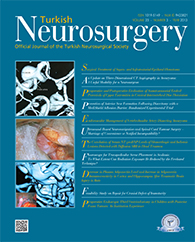2Kafkas University, Faculty of Medicine, Department of Neurosurgery, Kars, Turkey DOI : 10.5137/1019-5149.JTN.4666-11.3 This study aims to determine the dysfunction caused by existing pathological condition in structures involved in the transfer of sensory functions of the neural system in cervical disc herniation, and to establish whether or not the level and degree of this anatomical damage can be anticipated by SEP (Somatosensorial Evoked Potentials).
We compared the obtained SEP values for statistical significance using the Friedman Variation Analysis. In parameters with statistical significance, the Wilcoxon Signed Rank test was used to identify when significant improvements occurred.
The study found that the statistical data of the latency of the N14 wave originating from the dorsal column nuclei of the medulla spinalis and dorsal column gray matter improved (p<0.05) in the postoperative period compared with the preoperative values. Using the Wilcoxon Signed Rank test, we studied postoperative months separately in regard to the difference in the latency of the N14 wave, and found the statistically significant improvement to be marked particularly in months 3 and 6 postoperatively (p<0.05).
In conclusion, we suggest that SEP is a useful tool to check the functional condition of the dorsal spinal column. The benefit of the SEP utilization is the ability to determine the severity of the pathological condition preoperatively and follow the patient’s functional postoperative improvement.
Keywords : Cervical disc herniation, Somatosensory evoked potentials




